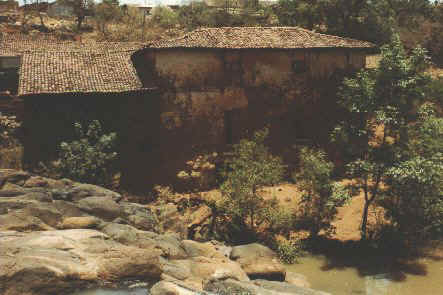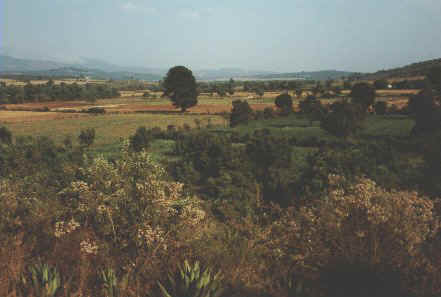 The old Guascuaro wheat mill
The old Guascuaro wheat mill The old Guascuaro wheat mill
The old Guascuaro wheat mill
The village of Guascuaro lies to the north-west of Tingüindín, on the modern main road which connects Los Reyes with the valley of Zamora. In the era of the haciendas, it was, however, more closely connected with the Ciénega de Chapala, its people passing the borders of the Guaracha hacienda en route to the commercial town of Sahuayo. The local hacendados saw Guaracha as the centre of their universe, and workers who offended them would be blacklisted throughout the region.
Guascuaro today sees itself as a mestizo community, distinct from its close neighbour Tarécuato, which conserves its Purépecha identity, although many of its people today earn their living in California. This may well have been the result of changes brought about by the 19th Century liberal reforms. In the past Tingüindín, famous for its bread, had been the seat of an indigenous elite, but the 19th century saw the take over of municipal centres by families which saw themselves as mestizo and a peripheralization of the indigenous communities. Guascuaro itself had been a centre for milling wheat, with a water driven mill. It was granted an ejido under Cárdenas, but its fertile bottom lands and forest resources were coveted by powerful commercial interests with links to Guadalajara. In Guascuaro, a family of vicious local bosses not merely dominated the ejido, but virtually eliminated it in the 1950s through violence, murdering many of the original beneficiaries of the land reform. For years the cacique families treated the ejido lands as their private property, and were able to benefit greatly when the avocado boom developed in the region. Many of the communal lands that indigenous communities had retained in this region were also taken over by private interests in this period.
 Disputed ejido land in the valley bottom
Disputed ejido land in the valley bottom
The neo-populist rhetoric of the government of Luis Echeverría in the early 1970s convinced many in Guascuaro that the time was ripe for an attempt to recover their land. Echeverría sanctioned significant land expropriations in Northern Mexico in this period, even taking land from American owners to create new ejidos. The people of Guascuaro had survived the hard years of boss rule by migrating to the United States and working as field hands and some of them had accumulated enough savings and financial security to feel that the risk of confronting the bosses was worthwhile. In the video, the community's leader, Don Angel, relates some of the history of the struggle, which finally bore fruit after the community aligned itself with the UCEZ. When Cuauthémoc Cárdenas was the PRI state governor, at the end of the Seventies and beginning of the Eighties, he gave a certain amount of ambiguous support to the radical agrarian movement. In the case of Guascuaro, however, the case was relatively clear cut: a legitimately constituted ejido had been destroyed by intimidation, violence and acts of murder. The fact that it took the people of Guascuaro so long to recover their patrimony illustrates the difficulties of securing justice even under the old agrarian legislation.
Nevertheless, the struggle was finally successful, and the Guascuaro militants continued to aid other communities aligned with the UCEZ after their own triumph. One of the interesting points that emerges in the interview with Don Angel is his attitude to indigenous people. He worked closely with Efren Capiz, the UCEZ leader, and admired him as a brilliant lawyer who was also an indigenous person. But he still sometimes referred to indigenous people as "inditos" (the diminutive, a rather disparaging usage) and "naturales" (the colonial term for Indians). He sees them as different from people like himself in an essentialist way, as having different "natures". This is particularly intriguing in someone who has, on occasion, literally risked his life standing shoulder to shoulder with people from other communities who have retained a sense of themselves as indigenous Purépechas.
 Many Guascuaro ejidatarios also have avocado trees, although they face problems competing with big growers and are subject to sanitary controls by the Ministry of Agriculture which they see as a weapon wielded by the powerful to shut them out of the market.
Many Guascuaro ejidatarios also have avocado trees, although they face problems competing with big growers and are subject to sanitary controls by the Ministry of Agriculture which they see as a weapon wielded by the powerful to shut them out of the market.
These attitudes are not simply legacies of colonial racist conceptions, but products of the way even relatively radical leaders like Lázaro Cárdenas constructed Mexican nationalism in terms of the historically progressive role of mestizaje and saw the future as one in which "Indians" should "assimilate into the national mainstream" and cease to conserve any distinct cultural identity. Guascuaro is an interesting case because it illustrates the difficulties people have in reinventing their identities and that of their country by revalorizing their "Indian" side as something in which they can take pride. Nevertheless, it is interesting that when Salinas announced the Reform of Article 27, the ejidatarios of Guascuaro seriously discussed the possibility of having their ejido reclassified as communal land, since this is still protected under the Constitution from a majority decision in favour of privatizing land rights. Whatever happens, the history of the Guascuaro ejido gives it a very special symbolic value to the people who fought to reclaim it.
![]() In this first video clip, Don Angel describes how the caciques took control of over 333 hectares of Guascuaro's ejido land.
In this first video clip, Don Angel describes how the caciques took control of over 333 hectares of Guascuaro's ejido land.
![]() Don Angel describes the start of the struggle to reclaim the land under President Echeverría, which introduced the community to the bureaucratic complexities of "the juridical" and the need to establish their credentials through documentation.
Don Angel describes the start of the struggle to reclaim the land under President Echeverría, which introduced the community to the bureaucratic complexities of "the juridical" and the need to establish their credentials through documentation.
![]() Through the production of mountains of paper, the legal battle progressed to the point of engineers being sent to survey the disputed land. But the ejidatarios were repeatedly frustrated by the cacique's ability to secure injunctions against them.
Through the production of mountains of paper, the legal battle progressed to the point of engineers being sent to survey the disputed land. But the ejidatarios were repeatedly frustrated by the cacique's ability to secure injunctions against them.
![]() Don Angel describes how, as comisariado ejidal, he developed a close working relationship with Efren Capiz, the charismatic lawyer who led the UCEZ, and was sent by him to other communities. Don Efren had an incomparable experience and knowledge of agrarian law, but in emphasising his indigenous identity, seemed completely different to the other lawyers with whom Don Angel and his comrades had dealings.
Don Angel describes how, as comisariado ejidal, he developed a close working relationship with Efren Capiz, the charismatic lawyer who led the UCEZ, and was sent by him to other communities. Don Efren had an incomparable experience and knowledge of agrarian law, but in emphasising his indigenous identity, seemed completely different to the other lawyers with whom Don Angel and his comrades had dealings.
This is the last case study. Return to the main case study page here.